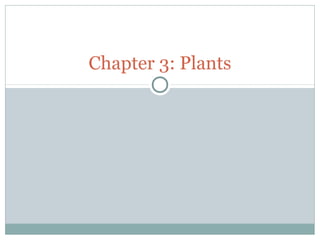
Chapter 3 plants
- 2. Summary Why are plants important? Evolution 4 major groups Life cycle – general Key lineages
- 3. Why are Plants Important? 3 categories: Ecosystem services Fuels and fibers Other
- 4. Evolution It started with green algae, confined to a watery environment, ~ 570 mya. Land plants 1st appeared about 450 mya, preceding land animals.
- 5. Evolution Invasion of land presented some of the same problems for plants as it did for animals:
- 6. 4 Major Groups Based on similar characteristics and order of evolution. Non-vascular land plants, mosses, liverworts and hornworts Vascular plants Seedless vascular plants, club mosses, ferns and horsetails Gymnosperms have “naked” seeds that protect embryo, conifers, cycads and ginkgos. Angiosperms have enclosed seeds (fruits) and flowers.
- 8. Life Cycle Alternates between sporophyte (2n) and gametophyte (n) generations. In early land plants the gametophyte stage predominates, later the sporophyte stage dominates.
- 10. Nonvascular Plants (Bryophytes) Characteristics Gametophytes are photosynthetic, sporophytes are attached to gametophytes and depend on them for nutrition. Require water to reproduce Most are small and live in moist, temperate environments.
- 11. Non Vascular Plants Phylum Hepaticophyta – liverworts
- 12. Nonvascular plants Phylum Anthocerophyta Phaeocerus leavis – hornworts Gas Exchange: Stomata (the rest of the plant kingdom has stomata). Tiny “broom handles” extending from rhizoids (above ground anchors to substrate).
- 13. Nonvascular Plants Phylum Bryophyta – mosses *source of peat Rhizoid = anchor, supports “leaves” which are 1 cell thick.
- 15. Vascular Plants Major developments Vascular tissues to… Vessels – vascular tissue modified to provide structure in later species. 2 groups: seedless and seed bearing
- 16. Seedless Vascular plants Characteristics Primitive vascular tissue. Roots *Still dependent on water for transport of sperm to egg.
- 17. Seedless Vascular Plants Phylum Lycophyta – club mosses Extinct varieties were tree- like but surviving species are small. Major source of coal.
- 18. Seedless Vascular Plants Phylum Psilotophyta Whisk ferns: no leaves or roots, grow on rhizoids or they are epiphytes. Horsetails: photosynthetic stems, leaves are less prominent than stems in some varieties. Grow well in wet, boggy areas.
- 19. Seedless Vascular Plants Phylum Pteridophyta - ferns Most abundant, closest relative to seed plants. Fern sporangia
- 21. Seed-bearing Vascular Plants Ch 28 Characteristics Sporophyte stage dominates. Major development is the seed that protects embryo and allows for a dormant period. 2 types of gametophytes or structures: Male (pollen-sperm) and Female (ovary – eggs)
- 22. Seed-bearing Vascular Plants 2 groups Gymnosperms – “naked” seeds. Ovules (eggs) are partially exposed on scales; sperm are motile or nonmotile. Angiosperms – “vessel” seeds (fruit). Ovules are totally enclosed, sperm are motile.
- 23. Seed-bearing Vascular Plants Gymnosperms – 4 phyla Gnetophyta – Cycadophyta (cycads) – Ginkgophyta –
- 24. Cycad Ginkgo
- 26. Seed-bearing Vascular Plants Gymnosperms – 4 phyla cont’d Coniferophyta (conifers) – largest group; pines, firs, cedars, yews, cypresses, etc. Produce male and female cones. Pollen grains and ovules develop at the base of scales. Pollen grains float into female cones and stick on ovules. Female cones take 1-2 seasons to mature and release their seeds.
- 29. Seed-bearing Vascular Plants Anthophyta (Angiosperms) – Characteristics Flowers and fruits Dominate the plant world
- 30. Seed-bearing Vascular Plants Anthophyta – 6 clades. Basal angiosperms: Amborella, water lilies, star anise. Core angiosperms: Magnoliids – magnolias, laurels, etc. Monocots – derived from Magnoliids, 1 cotyledon (seed leaf), no woody tissue, leaf veins parallel, flower parts are multiples of 3. Lilies, grasses, yucca, irises Eudicots (true dicots) – 2 cotyledons, leaf veins are web-like, woody tissue, flower parts are multiples of 4-5. Trees, shrubs, annuals.
- 32. Figure 30-23 30-23a Angiosperms – what is the purpose of flowers? “Corpse” flowers smell like rotting flesh and attract carrion flies.